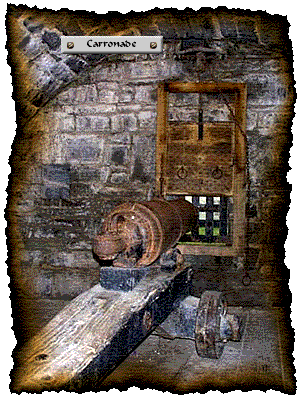
This specialized form of ordnance was invented and first manufactured by the Carron Foundry at Falkirk, Scotland. Carronades are about seven calibres long, without any trunnions, but with a loop under the barrel to attach them to the carriage. Carronades were capable of firing solid shot, as well as case and cannister shot, and were named by the shot weight.

Carronades were designed primarily for use in confined spaces, such as the gun decks of ships and casemates of forts, in order to fire heavy shot at close quarters. They were thinner in the wall of the barrel than ordinary guns. Therefore, they needed a smaller charge (one twelfth of the weight of the shot).
A shorter barrel and a smaller charge meant that their effective range was very short. In a fortification, they were generally used for flank protection. Carronades were generally ineffective beyond 800-1,000 yards. The advantage of carronades was in their lightness and the small number of men to work them. Carronades came into British service in 1779 and were considered almost obsolete after the mid-1800s. For a time they were deemed the most effective naval gun by the Royal Navy, which liked to fight at close range. This tactic tended to nullify the enemy’s advantage of longer-range guns.

Next Page: Artillery Tactics...
![]()